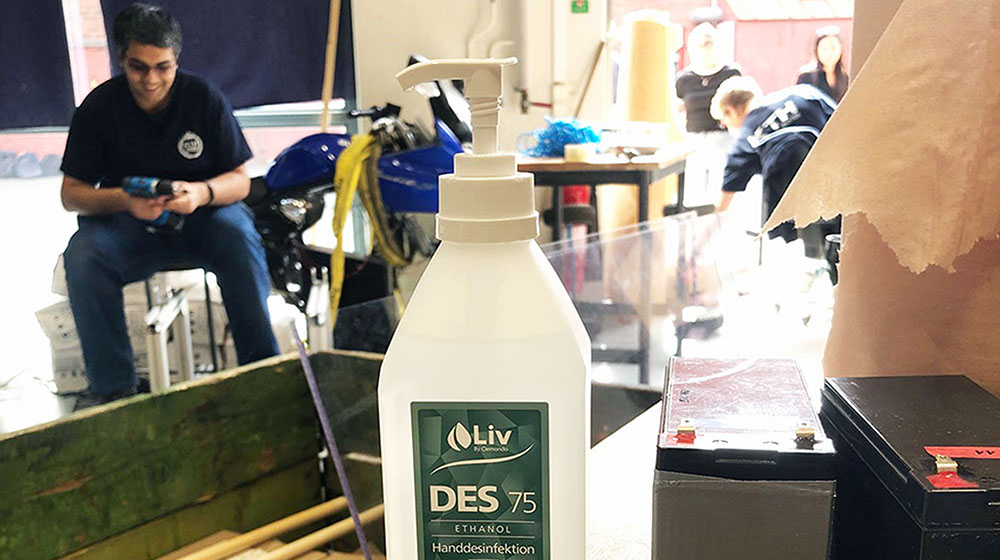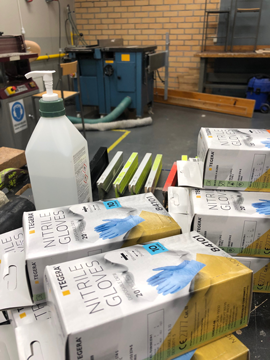Now Machine design is corona safe(r)

The students are largely back on campus. But the corona pandemic is not over. How do you minimize the risk of infection when on-site education starts up again? At the department of Machine Design (MMK), the staff has worked hard to develop safety routines for the autumn semester.
At MMK, just where the Lill-Jan forest begins and at the far end of the campus, there are about 40 rooms aimed for teaching the department's students. A large proportion of the teaching takes place in MMK’s own facilities, here they have prototype rooms, workshops, project rooms, labs, soldering rooms, meeting rooms and classrooms. And all of them must function - despite restrictions - now that the students are back.
”We usually have around 200 students in the house at the same time, but this autumn we’ll have the 40 rooms in use, but making sure that not everyone is in place at the same time. We have reduced the maximum number of people per room to about a third and by using time slots, students can either take turns, or spread out in the rooms next door”, says Marin Edin Grimheden, head of department and the person who’s been coordinating the corona planning from a safety perspective.
” It’s easy to say that teaching should be digitized or carried out at a distance, but during this spring it became clear that not all teaching could be digitized. Therefore, we need to make our own decisions and introduce our own routines.”
The main goal is that all students must feel sure that it’s possible to possible to keep a distance of 1.5-2m to all other people in the house.

” In some specific experiments where we can’t keep this distance, we have asked medical expertise to develop routines where students use visors, gloves and disinfection liquid under the supervision of the responsible teacher. We also receive very good support from the Service center, who refills desinfectants and gloves in all 40 of our classrooms three times a week.
Throughout the spring, KTH manufactured visors for the healthcare sector. This summer and autumn, MMK has also manufactured its own visors to be able to implement certain critical elements in the teaching.
The premises can be booked via an external booking system, so everyone can see where there is a risk of a lot of people gathering and the students have access to the facilities 24-7 and are encouraged to use evenings and weekends to avoid rush hour traffic both at SL and in the house.
” During the last two weeks, for example during the reception of students in year one, it has become clear that the absolute majority of students do not follow the distance recommendations on campus. Teachers are increasingly anxious. If we have thousands of students on campus who do not follow distance recommendations, it becomes even more important how we act, and especially in the interaction between teachers and student groups. We have therefore separated the environments in the house so that no one moves in areas where you do not have to be.
Director of Studies Gunilla Ölundh Sandström has also worked hard with the new safety routines to be able to receive students on campus. What kind of teaching does not work at a distance, then?
” At MMK, we largely teach construction and design. This activity is often creative, divergent, creative and rarely follows traditional methods. We want our students to experiment, create, do things, test and challenge themselves and each other. This is based on teamwork and hands-on work. This is difficult to implement at a distance, even if we Zoom supervision and more formal project meetings. But the learning process is very much a social process”, says Gunilla.
” The overall socialization into the role of engineer is seldom discussed in the context of digitization. We train the engineers who will lead the development in the future, and we believe that it’s critical that today’s students have the same opportunities as the previous ones - from abilities in social interactions to engineering skills.”
Like all research environments at KTH, MMK has employees from all over the world. Gunilla Ölundh Sandström says that people followed a diversity of recommendations during the pandemic spring.
” As Sweden's approach has been different from many other countries, a large part of the employees have chosen to follow other, more strict, recommendations. It has therefore been important to find a common ground to stand on”.
Text: Anna Gullers